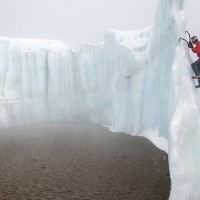Date: 27th January 2021
 What can I do about climate change?
What can I do about climate change?
Why do anything? For me, it’s personal. In the last five years I’ve worked on glacial/climate research projects in Greenland, Africa and Canada, and personally watched radical change in the Rockies, Alps and other mountain ranges for decades. Rather than just reading about climate change, I’ve been swinging ice tools into it, and working directly with some of the most cutting edge researchers in the world. Melt water in Greenland. Disappearing ice on top of Kilimanjaro, really massive change in less than 5 years. I almost died when some permafrost let go above me while I was guiding, and a local mountain hut that has stood there for more than 100 years is unstable now due to the permafrost melting. In short, climate change is very obvious and personal to me. It’s not a “theory,” the ice in my world is literally disappearing faster than natural processes account for, and this effects me personally and professionaly. But what to do about it?
For me the answer has three parts:
1. Vote. We need sane policies at a national and international level or change won’t be effective.
2. Use less carbon personally and professionally. See below.
3. Show the world what I see so they can too, and publicly advocate for change with acceptance and respect, not anger or shame.
As a guide and a professional athlete/poseur/speaker that flies a ridiculous amount I produce a huge amount of carbon. The first step for me was deciding that what I was doing was a problem, and that I would try to do something about it personally. It won’t be perfect, but if we use the IPCC targets as personal goals then change starts to look a lot more feasible:
“The world would have to curb its carbon emissions by at least 49% of 2017 levels by 2030 and then achieve carbon neutrality by 2050 to meet this target, according to a summary of the latest IPCC report, released on 8 October”
That’s the kind of bare minimum, but I think most of us can do that without too much drama. Personally, I’m shooting for getting to 50 percent or less of my 2019 carbon footprint by 2021 and neutral by 2025.
Here are some steps I’ve taken (with my family):
-Calculate our footprint: https://protectourwinters.org/cost-of-carbon/. This was an eye-opener for me about what activities used the most carbon. We have to know the problem areas before we can mitigate our overall footprint. I’m embarrassed by how much carbon my lifestyle produces, it really is insane.
-Drive a more fuel efficient vehicle. Our small station wagon gets over twice as good mileage as my truck. I don’t really need to drive that truck as often as I used to. Ultimately go electric, but just this saves us many thousands of pounds of carbon/year.
-Switch to renewable fuels as much as possible for our grid power. This is an option where I live, and seems to be decent. Solar better, but for now this seems better.
-Fly less, and don’t generally fly business. Hit multiple goals on one trip to Europe/Asia instead of flying long haul over a dozen times/year. My peak flying was over 150K/year, often in business. Even before Covid I’d reduced it to less than 75K, and would like to keep it under 50k/year. The last year has shown me that most meetings I’d previously fly to the east coast/Europe for a day can now be done over Zoom.
-Be like Greg Hill and be a “weekday” vegetarian, and mostly eat meat I hunted for the rest. The “weekday veg” is surprisingly easy to do. I’m not a natural vegetarian, if I can do this then anyone can. It doesn’t have to be “perfect,” just better. An occasional Tuesday hamburger is OK. http://shrinkthatfootprint.com/food-carbon-footprint-diet
-Buy local foods more. I will pay a little extra for high-quality local food.
-Canmore is not a great place to grow things, but we grew a garden this year for the first time here, and it produced a surprising amount of food. We weren’t buying California or BC lettuce for most of the summer, and the carrots were great. We’ll try again this year.
-Make my house more energy efficient. Work in progress.
-Heat with wood more. It’s at least renewable. Maybe, some of your comments have me rethinking this.
-Replace aging gear with lower carbon options. My chainsaw recently died, and I bought an electric one to replace it. It rips!
-Buy carbon offsets for projects that simply wouldn’t happen if I didn’t buy those offsets. Only do this as a last resort, but there are a few decent companies. Links below.
-I also rely on helicopters for the film work I do. Interestingly, they aren’t as heinous, relatively speaking, as I thought. Thirty hours of flight time/year in the machines I’m in is less than one round-trip to Europe, or driving to the desert and back in the fall… My international flights are way, way worse. It’s tricky to get rid of them, but again I can make my crews smaller, and cut the number of trips. If I can do that by even 20 percent it makes a difference, and the goal isn’t to totally remove it but just reduce it.
-Install solar. Working on this.
Even if I fall short at least I’m reducing my footprint below the IPCC for sure. I recognize that I’m a poster child for carbon output, but I can and have made real changes. Overall they’ve actually mostly been fun and positive! I’ll still be a criminal, but less of one.
Carbon Offset Links:
POW: https://protectourwinters.org/cost-of-carbon/
POW Challenge (fun): https://protectourwinters.ca/the-12-month-challenge/
Savick: https://www.savick.ca/offset-shop
Gold Standard: https://www.goldstandard.org
Films I’ve worked on involving climate change:
Greenland: Beneath the Ice
Kilimanjaro: The Last Ascent
Posted in: Blog
No comments yet... add your voice!
I'm more than happy to hear your thoughts on what I've written. Please note that all comments will be moderated before publishing. Thank you for joining the conversation.



